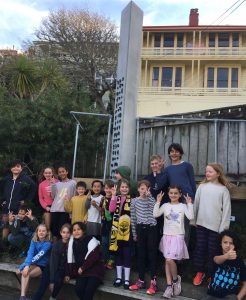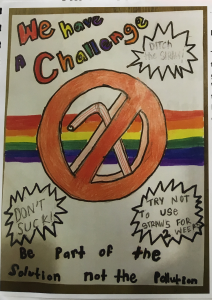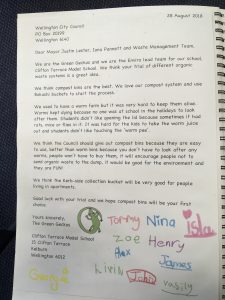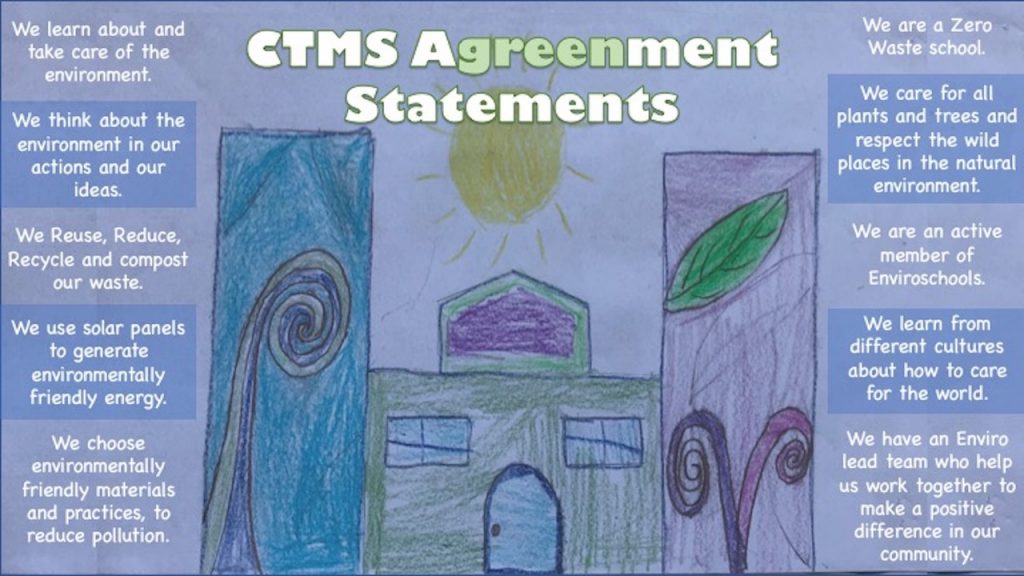
Clifton Terrace Green-Gold
When the students at Tinui School in the Wairarapa countryside heard there was a small urban Green-Gold Enviroschool (roll of 70) on a tiny little site within the Wellington Central Business District, they wondered how that could work. How could such a small school, in amongst all that concrete and traffic, make a “Green-Gold” kind of a difference to sustainability?
In 2018, the Enviroschools Green-Gold reflection at Clifton Terrace Model School (CTMS) showed that while the inner city environment and small size of the school might offer some interesting challenges, the school has taken advantage of a great range of opportunities related to sustainability.
There is no need for a school to be in a bush setting to make connections with nature and the size of a school’s contribution to sustainability is not reliant on the size of the school. Sustainability is really about how different parts of the community connect with one another and Clifton Terrace engages fully with the wider community.

CTMS students propagate seeds at Enviroschools event at Otari Wiltons Bush.
Proximity to a motorway no barrier to connecting with nature
Being tucked in beside a motorway might seem problematic to students developing a strong nature connection, but the CTMS students tell us you just have to open the gate to find nature in Wellington City. Right outside the gate is the town belt. The students can, and do, make regular trips to some of the wonderful bush spaces set aside in the city.
They have been to Otari Wilton’s Bush where they explored a range of aspects of the natural environment, including propagating plants, and they have participated in a Bioblitz at Zealandia, been part of a beach clean-up and planting with Sustainable Coastlines, and they regularly visit the Botanic Gardens to take part in activities organised for the community.
As part of their learning programme the students have thought carefully about what makes up a living landscape, identifying that soil, plants, air, animals and water are all important. They collect the dead leaves from around their school, add them to the compost and later use the compost to enhance the soil in their school’s small food garden before planting their seeds.
In keeping with their view that the city is an important part of their school community, they are looking into where they could regularly visit locally to build their knowledge and skills around gardening.
Opportunity for learning about some of the social aspects of sustainability

After an extensive student enquiry, the war memorial at Clifton Terrace Model School has been replaced.
Although it doesn’t stop the Clifton Terrace students connecting with nature, the motorway has had a significant impact on the school. The students learned that during its construction in 1971, their school lost the war memorial honouring past pupils and teachers who had served in the world wars. After a long learning enquiry guided by a parent and local historian, a stunning new memorial was constructed. Students had a whole new level of connection to a range of aspects of the school’s past.
Active citizens influencing community practices
Just as nature is right outside the school gates, so are a whole city of people to influence about sustainability issues. The envirogroup at Clifton Terrace Model School, the Green Geckos, tell us that they influence way more than just their own school when it comes to sustainability practices..
“You don’t need to be big to make a big impact. Our actions spread to the community”.

Ditch the straw challenge.

Participating in the community consultation process for waste management.
One example is in the area of waste. In a successful in-school focus on waste reduction, lunchbox waste was reduced by 70 percent!
The students built on this success and headed out into the community. As part of Keep NZ Beautiful Clean Up Week in 2018, they started removing litter from their local Tokyo Lane. They then held a pamphlet drop to encourage more responsible waste behaviour from the university students who reside there.
In 2019 the Clifton Terrace students have happily noticed there is less rubbish than there was a year ago.
And, with parliament in close proximity, it is no surprise that CTMS students are great lobbyists. They have participated actively in city council community consultation processes such as on waste management. The Green Geckos also ran a campaign challenging the rest of the school to stop using plastic straws during their holidays, petitioned for a plastic bag ban, and sold reusable bags as an alternative. Their local supermarkets no longer use plastic bags and they have noted many local businesses opting for paper straws.
A clear philosophy
The overall approach to caring for the Environment is laid out in the CTMS “Agreenment” developed by the 2017 Enviro lead team. The team drew together ideas from each class in the school and they are now held safely in this document to guide new generations of Clifton Terrace Model School students.
Ahakoa he iti he pounamu – Despite being small you are of great value.

CTMS ‘aGREENment’.
Clifton Terrace Model School highly values the opportunity to engage with the holistic nature of the Enviroschools kaupapa. The kaupapa is so important to the school that they release and pay for a teacher to run the Envirogroup in class time. This allows the students to explore sustainability deeply and work in a holistic way.
The students also highly value this opportunity and feel it is important in their lives:
“Being part of the envirogroup has helped me create stories”.
“In Samoan language week we looked at how climate change is affecting Samoa, and for those of us that are Samoan that was really amazing”.
“When I go to highschool, I want to join the Environment group there!”